INF70005 Strategic Project Management: Hershey ERP Project Analysis
VerifiedAdded on 2023/06/08
|12
|3121
|440
Report
AI Summary
This report critically evaluates Hershey's ERP implementation project, a well-known example of project failure, within the framework of strategic project management principles. It begins by outlining the project and company background, followed by a discussion of standard project success and failure criteria, including scope, time, budget, and stakeholder satisfaction. The report justifies the chosen criteria and then applies them to analyze the Hershey case, highlighting issues such as unrealistic timelines, inadequate testing, and a flawed 'big bang' implementation approach. The analysis reveals that the project failed to meet key success criteria, resulting in significant financial losses, reputational damage, and decreased stakeholder satisfaction. The report concludes by offering recommendations for avoiding similar pitfalls in future ERP implementations.
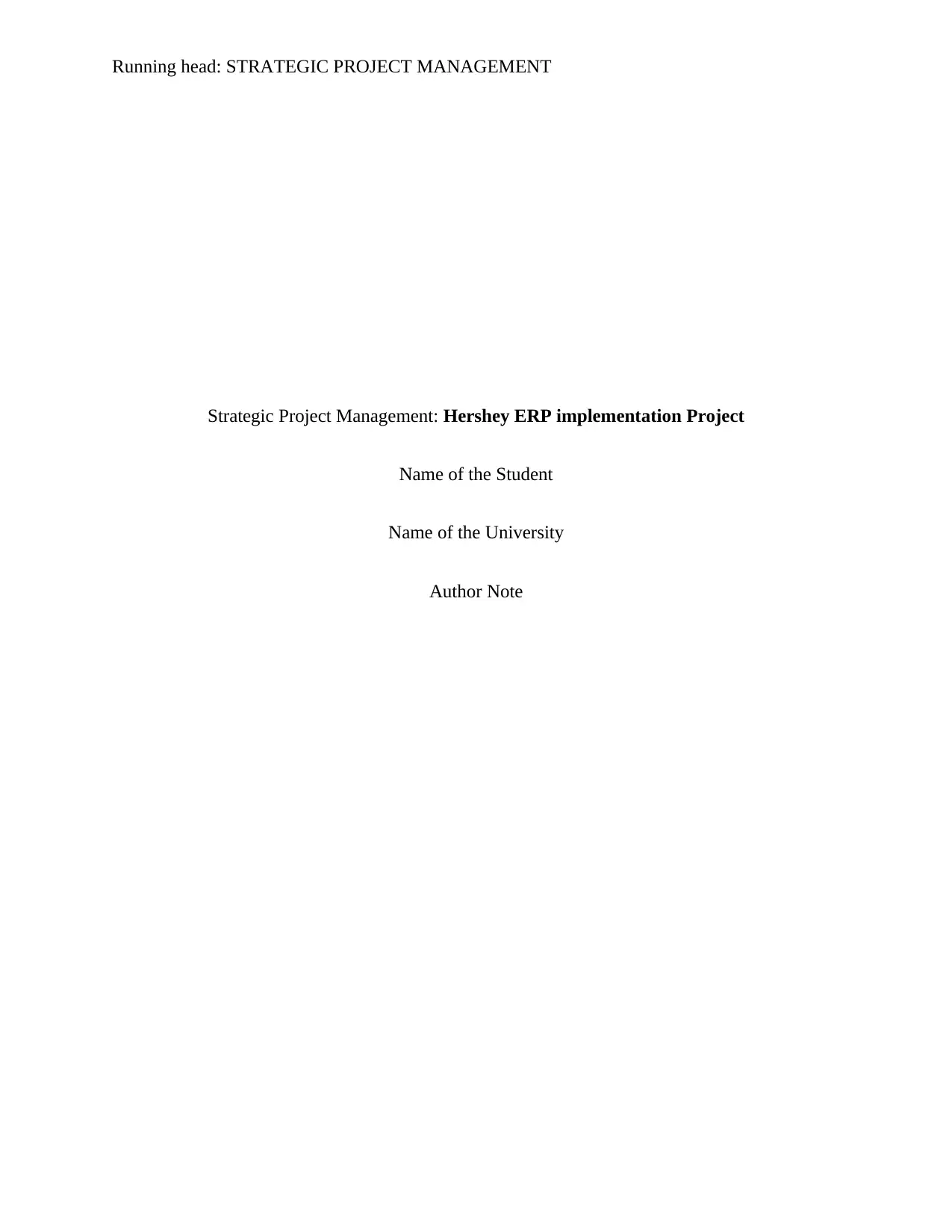
Running head: STRATEGIC PROJECT MANAGEMENT
Strategic Project Management: Hershey ERP implementation Project
Name of the Student
Name of the University
Author Note
Strategic Project Management: Hershey ERP implementation Project
Name of the Student
Name of the University
Author Note
Paraphrase This Document
Need a fresh take? Get an instant paraphrase of this document with our AI Paraphraser
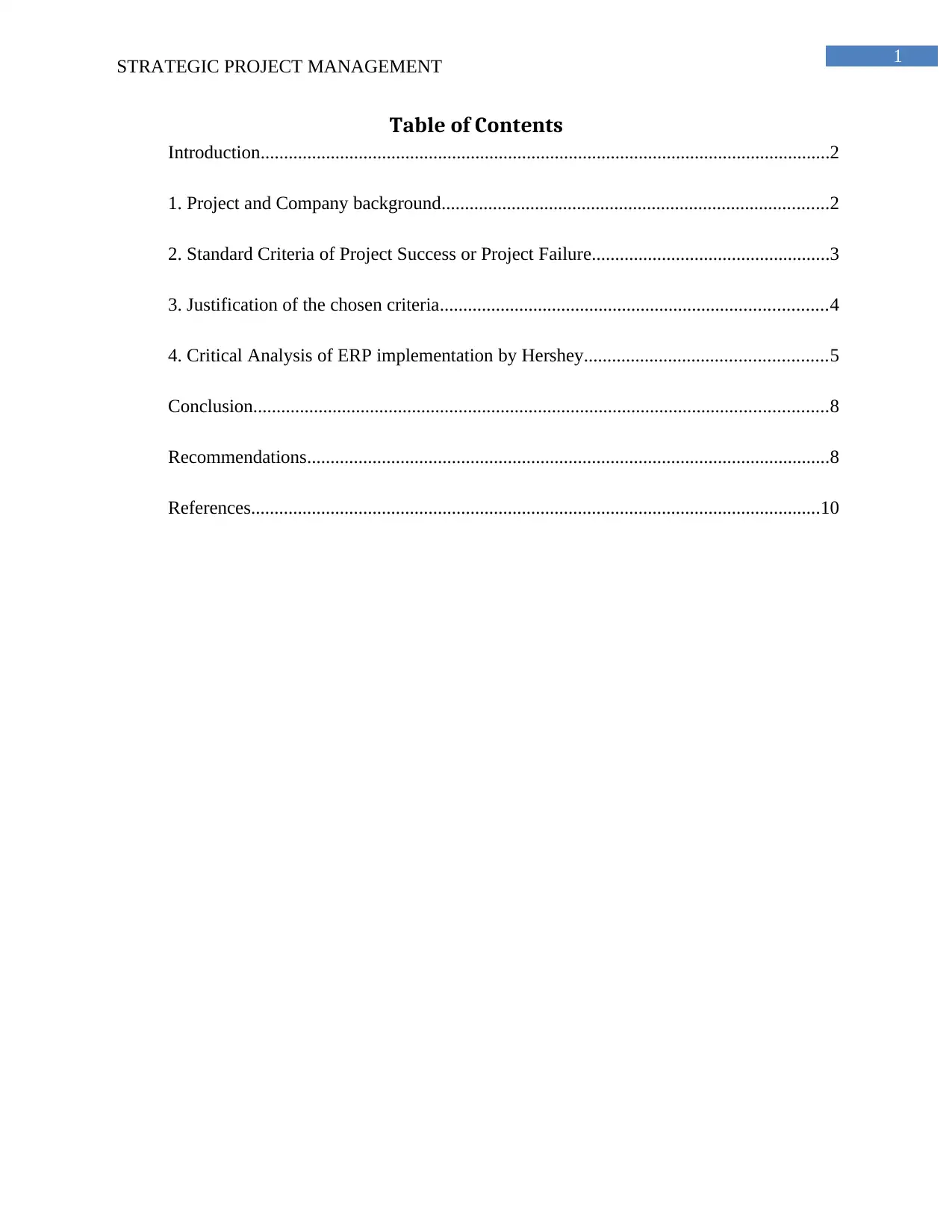
1
STRATEGIC PROJECT MANAGEMENT
Table of Contents
Introduction..........................................................................................................................2
1. Project and Company background...................................................................................2
2. Standard Criteria of Project Success or Project Failure...................................................3
3. Justification of the chosen criteria...................................................................................4
4. Critical Analysis of ERP implementation by Hershey....................................................5
Conclusion...........................................................................................................................8
Recommendations................................................................................................................8
References..........................................................................................................................10
STRATEGIC PROJECT MANAGEMENT
Table of Contents
Introduction..........................................................................................................................2
1. Project and Company background...................................................................................2
2. Standard Criteria of Project Success or Project Failure...................................................3
3. Justification of the chosen criteria...................................................................................4
4. Critical Analysis of ERP implementation by Hershey....................................................5
Conclusion...........................................................................................................................8
Recommendations................................................................................................................8
References..........................................................................................................................10
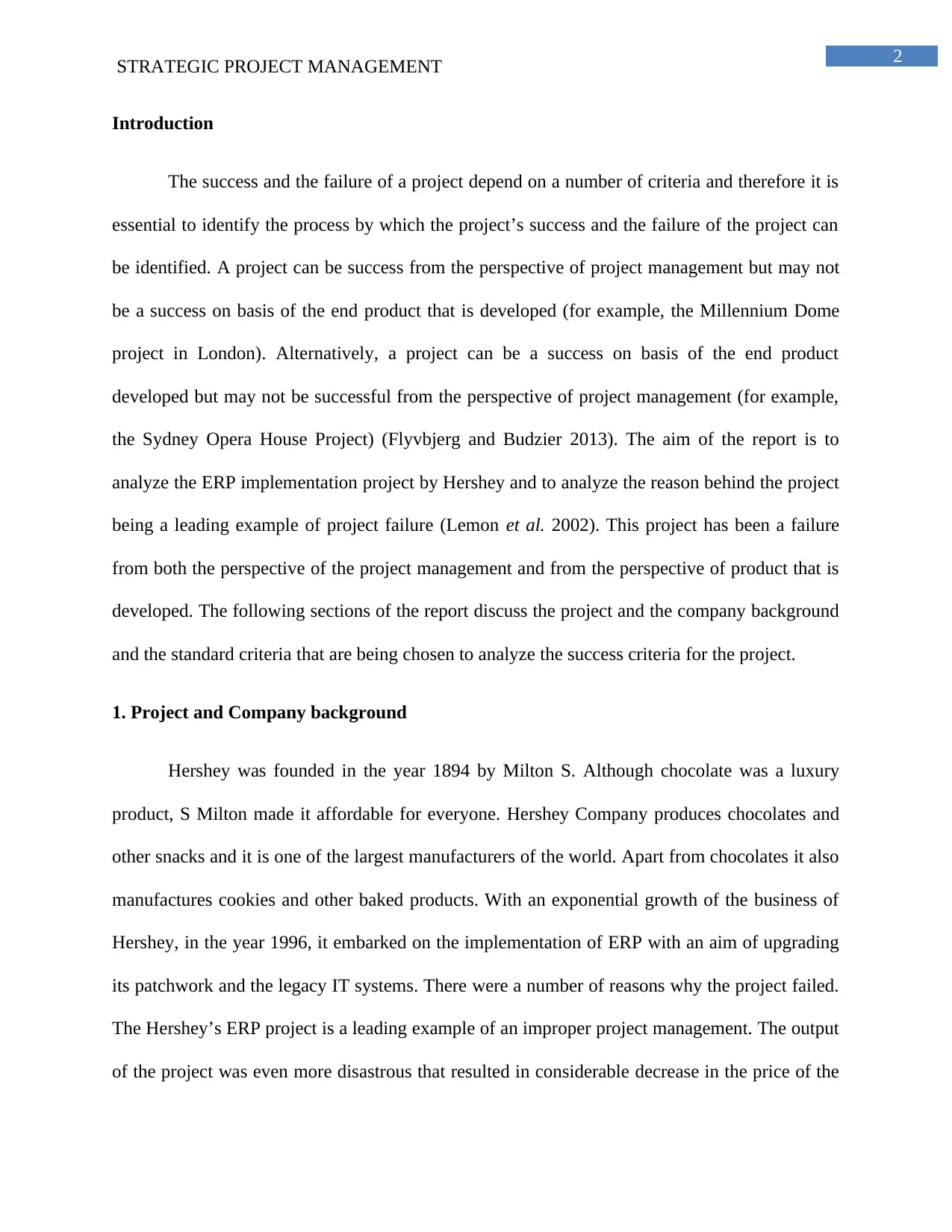
2
STRATEGIC PROJECT MANAGEMENT
Introduction
The success and the failure of a project depend on a number of criteria and therefore it is
essential to identify the process by which the project’s success and the failure of the project can
be identified. A project can be success from the perspective of project management but may not
be a success on basis of the end product that is developed (for example, the Millennium Dome
project in London). Alternatively, a project can be a success on basis of the end product
developed but may not be successful from the perspective of project management (for example,
the Sydney Opera House Project) (Flyvbjerg and Budzier 2013). The aim of the report is to
analyze the ERP implementation project by Hershey and to analyze the reason behind the project
being a leading example of project failure (Lemon et al. 2002). This project has been a failure
from both the perspective of the project management and from the perspective of product that is
developed. The following sections of the report discuss the project and the company background
and the standard criteria that are being chosen to analyze the success criteria for the project.
1. Project and Company background
Hershey was founded in the year 1894 by Milton S. Although chocolate was a luxury
product, S Milton made it affordable for everyone. Hershey Company produces chocolates and
other snacks and it is one of the largest manufacturers of the world. Apart from chocolates it also
manufactures cookies and other baked products. With an exponential growth of the business of
Hershey, in the year 1996, it embarked on the implementation of ERP with an aim of upgrading
its patchwork and the legacy IT systems. There were a number of reasons why the project failed.
The Hershey’s ERP project is a leading example of an improper project management. The output
of the project was even more disastrous that resulted in considerable decrease in the price of the
STRATEGIC PROJECT MANAGEMENT
Introduction
The success and the failure of a project depend on a number of criteria and therefore it is
essential to identify the process by which the project’s success and the failure of the project can
be identified. A project can be success from the perspective of project management but may not
be a success on basis of the end product that is developed (for example, the Millennium Dome
project in London). Alternatively, a project can be a success on basis of the end product
developed but may not be successful from the perspective of project management (for example,
the Sydney Opera House Project) (Flyvbjerg and Budzier 2013). The aim of the report is to
analyze the ERP implementation project by Hershey and to analyze the reason behind the project
being a leading example of project failure (Lemon et al. 2002). This project has been a failure
from both the perspective of the project management and from the perspective of product that is
developed. The following sections of the report discuss the project and the company background
and the standard criteria that are being chosen to analyze the success criteria for the project.
1. Project and Company background
Hershey was founded in the year 1894 by Milton S. Although chocolate was a luxury
product, S Milton made it affordable for everyone. Hershey Company produces chocolates and
other snacks and it is one of the largest manufacturers of the world. Apart from chocolates it also
manufactures cookies and other baked products. With an exponential growth of the business of
Hershey, in the year 1996, it embarked on the implementation of ERP with an aim of upgrading
its patchwork and the legacy IT systems. There were a number of reasons why the project failed.
The Hershey’s ERP project is a leading example of an improper project management. The output
of the project was even more disastrous that resulted in considerable decrease in the price of the
⊘ This is a preview!⊘
Do you want full access?
Subscribe today to unlock all pages.

Trusted by 1+ million students worldwide
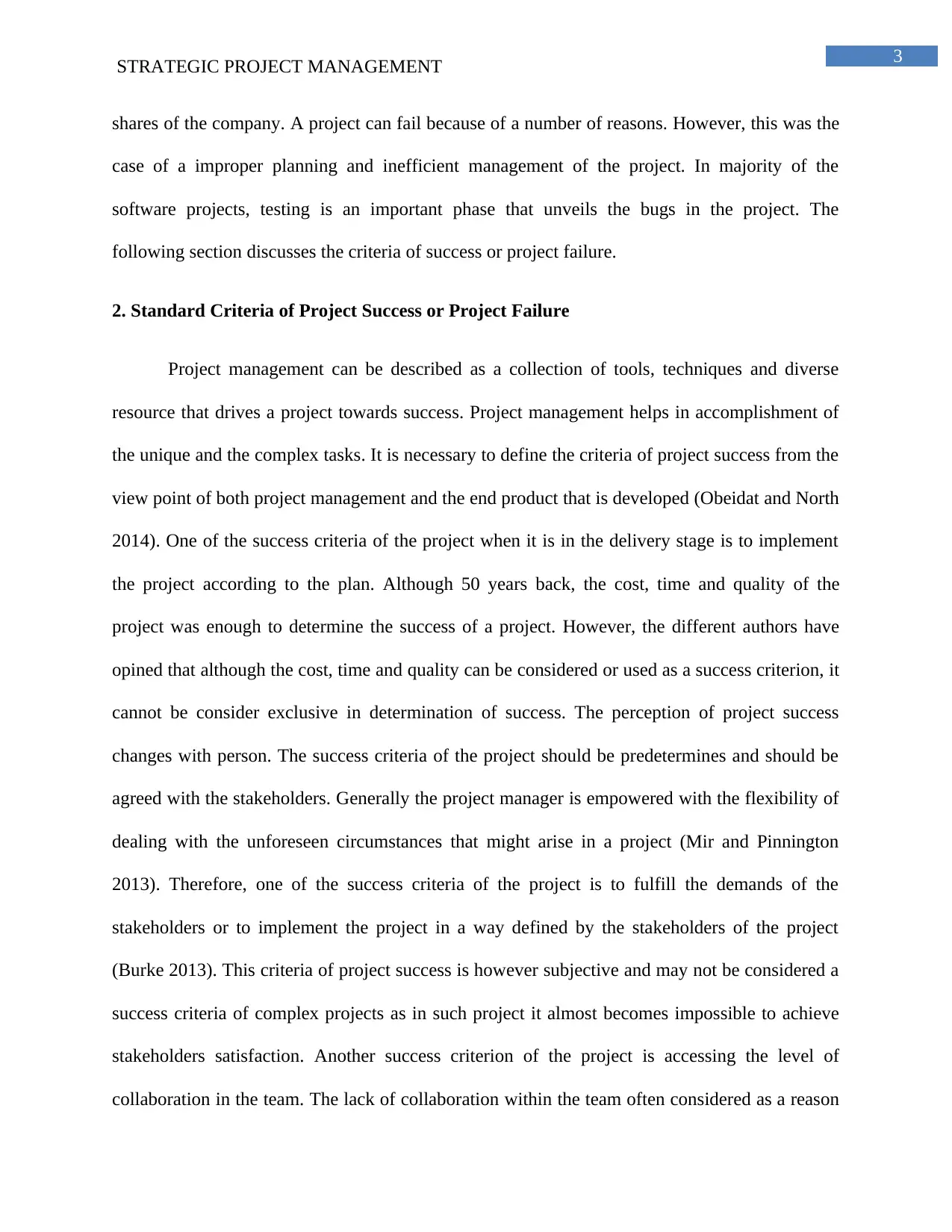
3
STRATEGIC PROJECT MANAGEMENT
shares of the company. A project can fail because of a number of reasons. However, this was the
case of a improper planning and inefficient management of the project. In majority of the
software projects, testing is an important phase that unveils the bugs in the project. The
following section discusses the criteria of success or project failure.
2. Standard Criteria of Project Success or Project Failure
Project management can be described as a collection of tools, techniques and diverse
resource that drives a project towards success. Project management helps in accomplishment of
the unique and the complex tasks. It is necessary to define the criteria of project success from the
view point of both project management and the end product that is developed (Obeidat and North
2014). One of the success criteria of the project when it is in the delivery stage is to implement
the project according to the plan. Although 50 years back, the cost, time and quality of the
project was enough to determine the success of a project. However, the different authors have
opined that although the cost, time and quality can be considered or used as a success criterion, it
cannot be consider exclusive in determination of success. The perception of project success
changes with person. The success criteria of the project should be predetermines and should be
agreed with the stakeholders. Generally the project manager is empowered with the flexibility of
dealing with the unforeseen circumstances that might arise in a project (Mir and Pinnington
2013). Therefore, one of the success criteria of the project is to fulfill the demands of the
stakeholders or to implement the project in a way defined by the stakeholders of the project
(Burke 2013). This criteria of project success is however subjective and may not be considered a
success criteria of complex projects as in such project it almost becomes impossible to achieve
stakeholders satisfaction. Another success criterion of the project is accessing the level of
collaboration in the team. The lack of collaboration within the team often considered as a reason
STRATEGIC PROJECT MANAGEMENT
shares of the company. A project can fail because of a number of reasons. However, this was the
case of a improper planning and inefficient management of the project. In majority of the
software projects, testing is an important phase that unveils the bugs in the project. The
following section discusses the criteria of success or project failure.
2. Standard Criteria of Project Success or Project Failure
Project management can be described as a collection of tools, techniques and diverse
resource that drives a project towards success. Project management helps in accomplishment of
the unique and the complex tasks. It is necessary to define the criteria of project success from the
view point of both project management and the end product that is developed (Obeidat and North
2014). One of the success criteria of the project when it is in the delivery stage is to implement
the project according to the plan. Although 50 years back, the cost, time and quality of the
project was enough to determine the success of a project. However, the different authors have
opined that although the cost, time and quality can be considered or used as a success criterion, it
cannot be consider exclusive in determination of success. The perception of project success
changes with person. The success criteria of the project should be predetermines and should be
agreed with the stakeholders. Generally the project manager is empowered with the flexibility of
dealing with the unforeseen circumstances that might arise in a project (Mir and Pinnington
2013). Therefore, one of the success criteria of the project is to fulfill the demands of the
stakeholders or to implement the project in a way defined by the stakeholders of the project
(Burke 2013). This criteria of project success is however subjective and may not be considered a
success criteria of complex projects as in such project it almost becomes impossible to achieve
stakeholders satisfaction. Another success criterion of the project is accessing the level of
collaboration in the team. The lack of collaboration within the team often considered as a reason
Paraphrase This Document
Need a fresh take? Get an instant paraphrase of this document with our AI Paraphraser
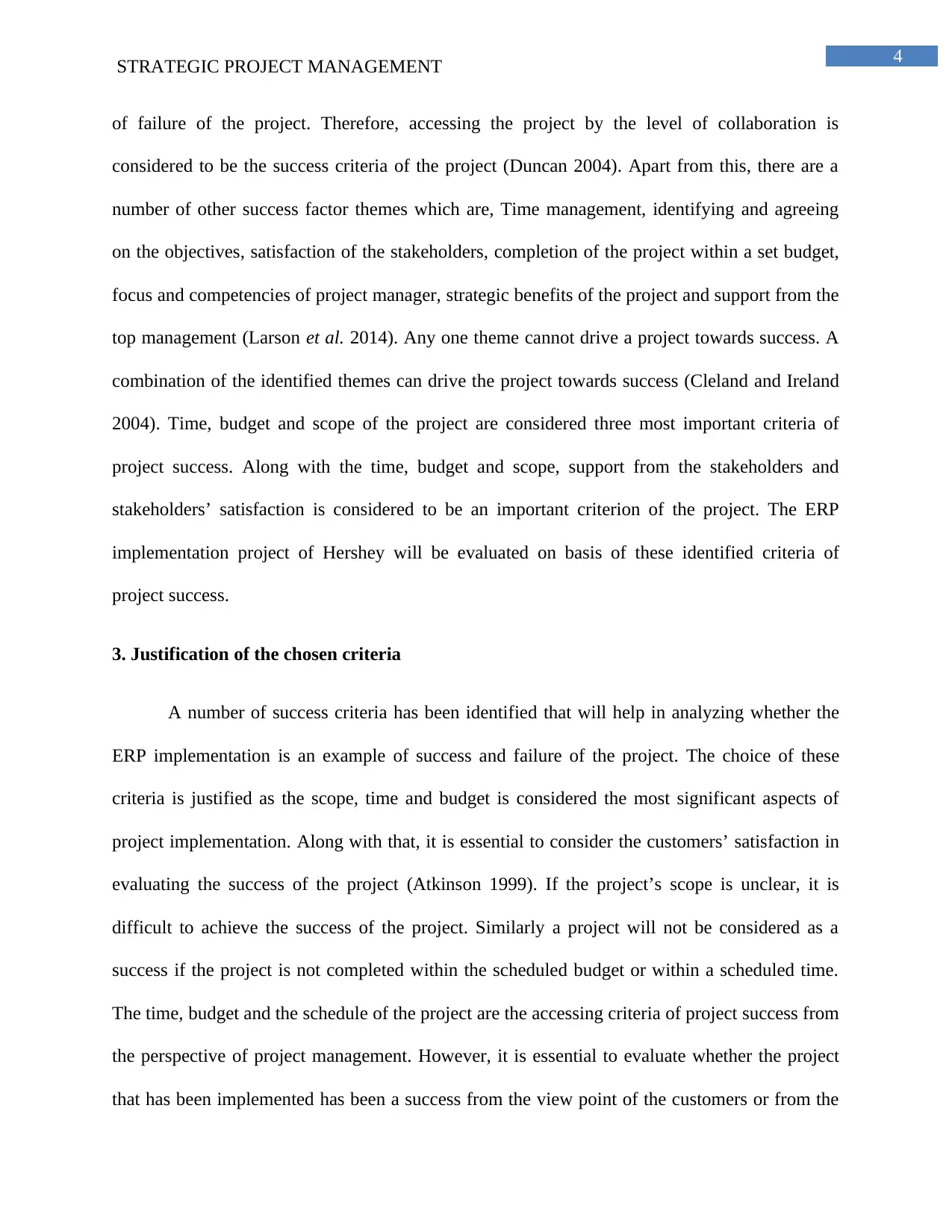
4
STRATEGIC PROJECT MANAGEMENT
of failure of the project. Therefore, accessing the project by the level of collaboration is
considered to be the success criteria of the project (Duncan 2004). Apart from this, there are a
number of other success factor themes which are, Time management, identifying and agreeing
on the objectives, satisfaction of the stakeholders, completion of the project within a set budget,
focus and competencies of project manager, strategic benefits of the project and support from the
top management (Larson et al. 2014). Any one theme cannot drive a project towards success. A
combination of the identified themes can drive the project towards success (Cleland and Ireland
2004). Time, budget and scope of the project are considered three most important criteria of
project success. Along with the time, budget and scope, support from the stakeholders and
stakeholders’ satisfaction is considered to be an important criterion of the project. The ERP
implementation project of Hershey will be evaluated on basis of these identified criteria of
project success.
3. Justification of the chosen criteria
A number of success criteria has been identified that will help in analyzing whether the
ERP implementation is an example of success and failure of the project. The choice of these
criteria is justified as the scope, time and budget is considered the most significant aspects of
project implementation. Along with that, it is essential to consider the customers’ satisfaction in
evaluating the success of the project (Atkinson 1999). If the project’s scope is unclear, it is
difficult to achieve the success of the project. Similarly a project will not be considered as a
success if the project is not completed within the scheduled budget or within a scheduled time.
The time, budget and the schedule of the project are the accessing criteria of project success from
the perspective of project management. However, it is essential to evaluate whether the project
that has been implemented has been a success from the view point of the customers or from the
STRATEGIC PROJECT MANAGEMENT
of failure of the project. Therefore, accessing the project by the level of collaboration is
considered to be the success criteria of the project (Duncan 2004). Apart from this, there are a
number of other success factor themes which are, Time management, identifying and agreeing
on the objectives, satisfaction of the stakeholders, completion of the project within a set budget,
focus and competencies of project manager, strategic benefits of the project and support from the
top management (Larson et al. 2014). Any one theme cannot drive a project towards success. A
combination of the identified themes can drive the project towards success (Cleland and Ireland
2004). Time, budget and scope of the project are considered three most important criteria of
project success. Along with the time, budget and scope, support from the stakeholders and
stakeholders’ satisfaction is considered to be an important criterion of the project. The ERP
implementation project of Hershey will be evaluated on basis of these identified criteria of
project success.
3. Justification of the chosen criteria
A number of success criteria has been identified that will help in analyzing whether the
ERP implementation is an example of success and failure of the project. The choice of these
criteria is justified as the scope, time and budget is considered the most significant aspects of
project implementation. Along with that, it is essential to consider the customers’ satisfaction in
evaluating the success of the project (Atkinson 1999). If the project’s scope is unclear, it is
difficult to achieve the success of the project. Similarly a project will not be considered as a
success if the project is not completed within the scheduled budget or within a scheduled time.
The time, budget and the schedule of the project are the accessing criteria of project success from
the perspective of project management. However, it is essential to evaluate whether the project
that has been implemented has been a success from the view point of the customers or from the
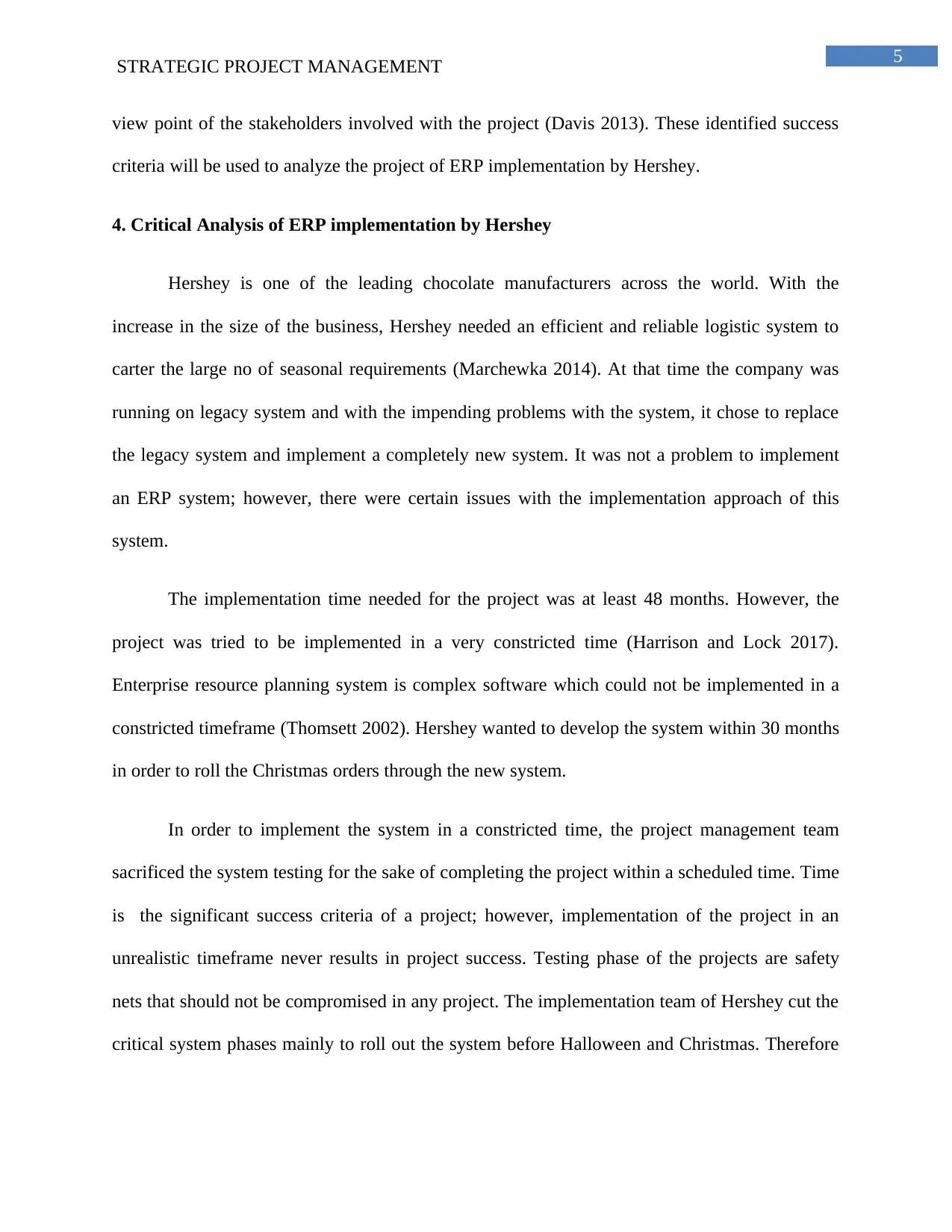
5
STRATEGIC PROJECT MANAGEMENT
view point of the stakeholders involved with the project (Davis 2013). These identified success
criteria will be used to analyze the project of ERP implementation by Hershey.
4. Critical Analysis of ERP implementation by Hershey
Hershey is one of the leading chocolate manufacturers across the world. With the
increase in the size of the business, Hershey needed an efficient and reliable logistic system to
carter the large no of seasonal requirements (Marchewka 2014). At that time the company was
running on legacy system and with the impending problems with the system, it chose to replace
the legacy system and implement a completely new system. It was not a problem to implement
an ERP system; however, there were certain issues with the implementation approach of this
system.
The implementation time needed for the project was at least 48 months. However, the
project was tried to be implemented in a very constricted time (Harrison and Lock 2017).
Enterprise resource planning system is complex software which could not be implemented in a
constricted timeframe (Thomsett 2002). Hershey wanted to develop the system within 30 months
in order to roll the Christmas orders through the new system.
In order to implement the system in a constricted time, the project management team
sacrificed the system testing for the sake of completing the project within a scheduled time. Time
is the significant success criteria of a project; however, implementation of the project in an
unrealistic timeframe never results in project success. Testing phase of the projects are safety
nets that should not be compromised in any project. The implementation team of Hershey cut the
critical system phases mainly to roll out the system before Halloween and Christmas. Therefore
STRATEGIC PROJECT MANAGEMENT
view point of the stakeholders involved with the project (Davis 2013). These identified success
criteria will be used to analyze the project of ERP implementation by Hershey.
4. Critical Analysis of ERP implementation by Hershey
Hershey is one of the leading chocolate manufacturers across the world. With the
increase in the size of the business, Hershey needed an efficient and reliable logistic system to
carter the large no of seasonal requirements (Marchewka 2014). At that time the company was
running on legacy system and with the impending problems with the system, it chose to replace
the legacy system and implement a completely new system. It was not a problem to implement
an ERP system; however, there were certain issues with the implementation approach of this
system.
The implementation time needed for the project was at least 48 months. However, the
project was tried to be implemented in a very constricted time (Harrison and Lock 2017).
Enterprise resource planning system is complex software which could not be implemented in a
constricted timeframe (Thomsett 2002). Hershey wanted to develop the system within 30 months
in order to roll the Christmas orders through the new system.
In order to implement the system in a constricted time, the project management team
sacrificed the system testing for the sake of completing the project within a scheduled time. Time
is the significant success criteria of a project; however, implementation of the project in an
unrealistic timeframe never results in project success. Testing phase of the projects are safety
nets that should not be compromised in any project. The implementation team of Hershey cut the
critical system phases mainly to roll out the system before Halloween and Christmas. Therefore
⊘ This is a preview!⊘
Do you want full access?
Subscribe today to unlock all pages.

Trusted by 1+ million students worldwide
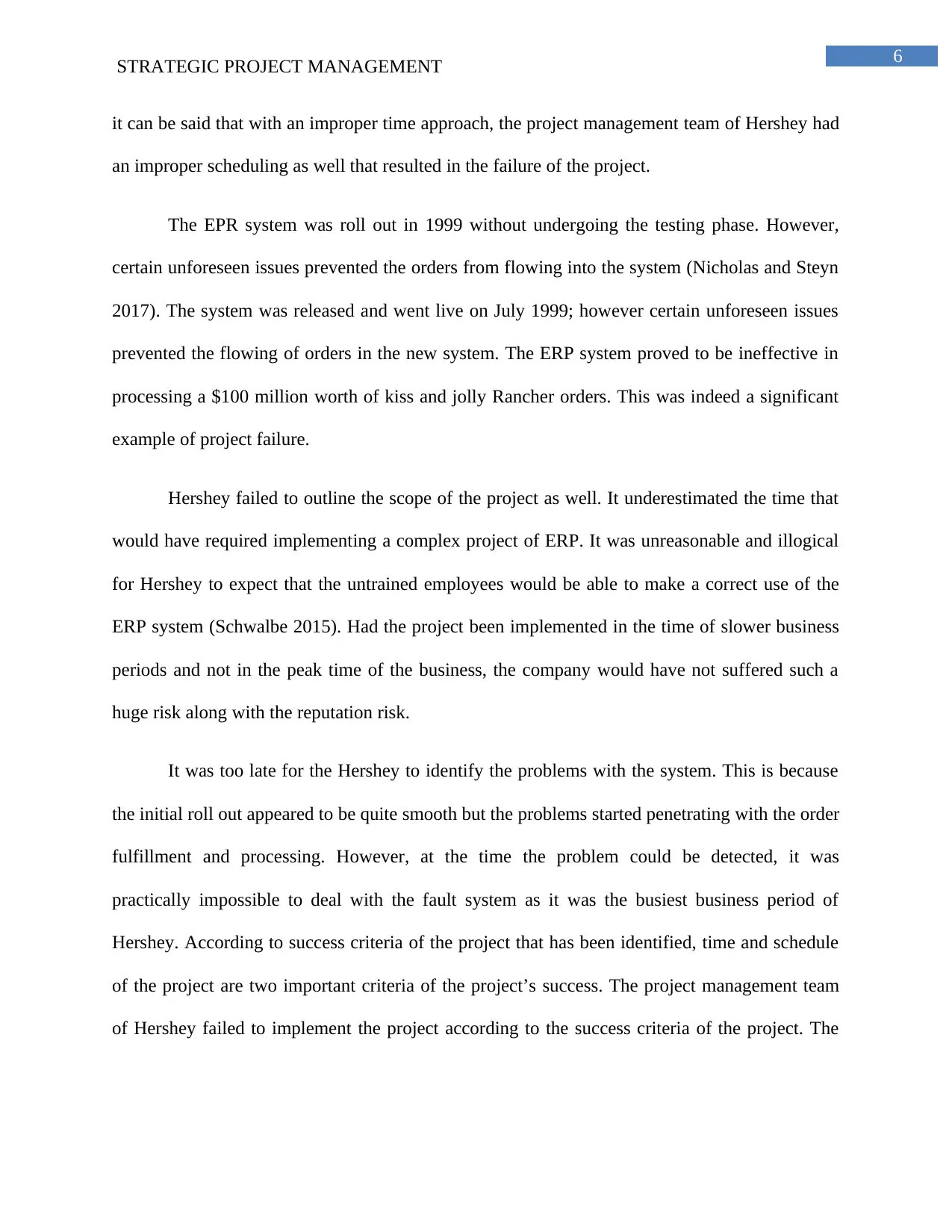
6
STRATEGIC PROJECT MANAGEMENT
it can be said that with an improper time approach, the project management team of Hershey had
an improper scheduling as well that resulted in the failure of the project.
The EPR system was roll out in 1999 without undergoing the testing phase. However,
certain unforeseen issues prevented the orders from flowing into the system (Nicholas and Steyn
2017). The system was released and went live on July 1999; however certain unforeseen issues
prevented the flowing of orders in the new system. The ERP system proved to be ineffective in
processing a $100 million worth of kiss and jolly Rancher orders. This was indeed a significant
example of project failure.
Hershey failed to outline the scope of the project as well. It underestimated the time that
would have required implementing a complex project of ERP. It was unreasonable and illogical
for Hershey to expect that the untrained employees would be able to make a correct use of the
ERP system (Schwalbe 2015). Had the project been implemented in the time of slower business
periods and not in the peak time of the business, the company would have not suffered such a
huge risk along with the reputation risk.
It was too late for the Hershey to identify the problems with the system. This is because
the initial roll out appeared to be quite smooth but the problems started penetrating with the order
fulfillment and processing. However, at the time the problem could be detected, it was
practically impossible to deal with the fault system as it was the busiest business period of
Hershey. According to success criteria of the project that has been identified, time and schedule
of the project are two important criteria of the project’s success. The project management team
of Hershey failed to implement the project according to the success criteria of the project. The
STRATEGIC PROJECT MANAGEMENT
it can be said that with an improper time approach, the project management team of Hershey had
an improper scheduling as well that resulted in the failure of the project.
The EPR system was roll out in 1999 without undergoing the testing phase. However,
certain unforeseen issues prevented the orders from flowing into the system (Nicholas and Steyn
2017). The system was released and went live on July 1999; however certain unforeseen issues
prevented the flowing of orders in the new system. The ERP system proved to be ineffective in
processing a $100 million worth of kiss and jolly Rancher orders. This was indeed a significant
example of project failure.
Hershey failed to outline the scope of the project as well. It underestimated the time that
would have required implementing a complex project of ERP. It was unreasonable and illogical
for Hershey to expect that the untrained employees would be able to make a correct use of the
ERP system (Schwalbe 2015). Had the project been implemented in the time of slower business
periods and not in the peak time of the business, the company would have not suffered such a
huge risk along with the reputation risk.
It was too late for the Hershey to identify the problems with the system. This is because
the initial roll out appeared to be quite smooth but the problems started penetrating with the order
fulfillment and processing. However, at the time the problem could be detected, it was
practically impossible to deal with the fault system as it was the busiest business period of
Hershey. According to success criteria of the project that has been identified, time and schedule
of the project are two important criteria of the project’s success. The project management team
of Hershey failed to implement the project according to the success criteria of the project. The
Paraphrase This Document
Need a fresh take? Get an instant paraphrase of this document with our AI Paraphraser
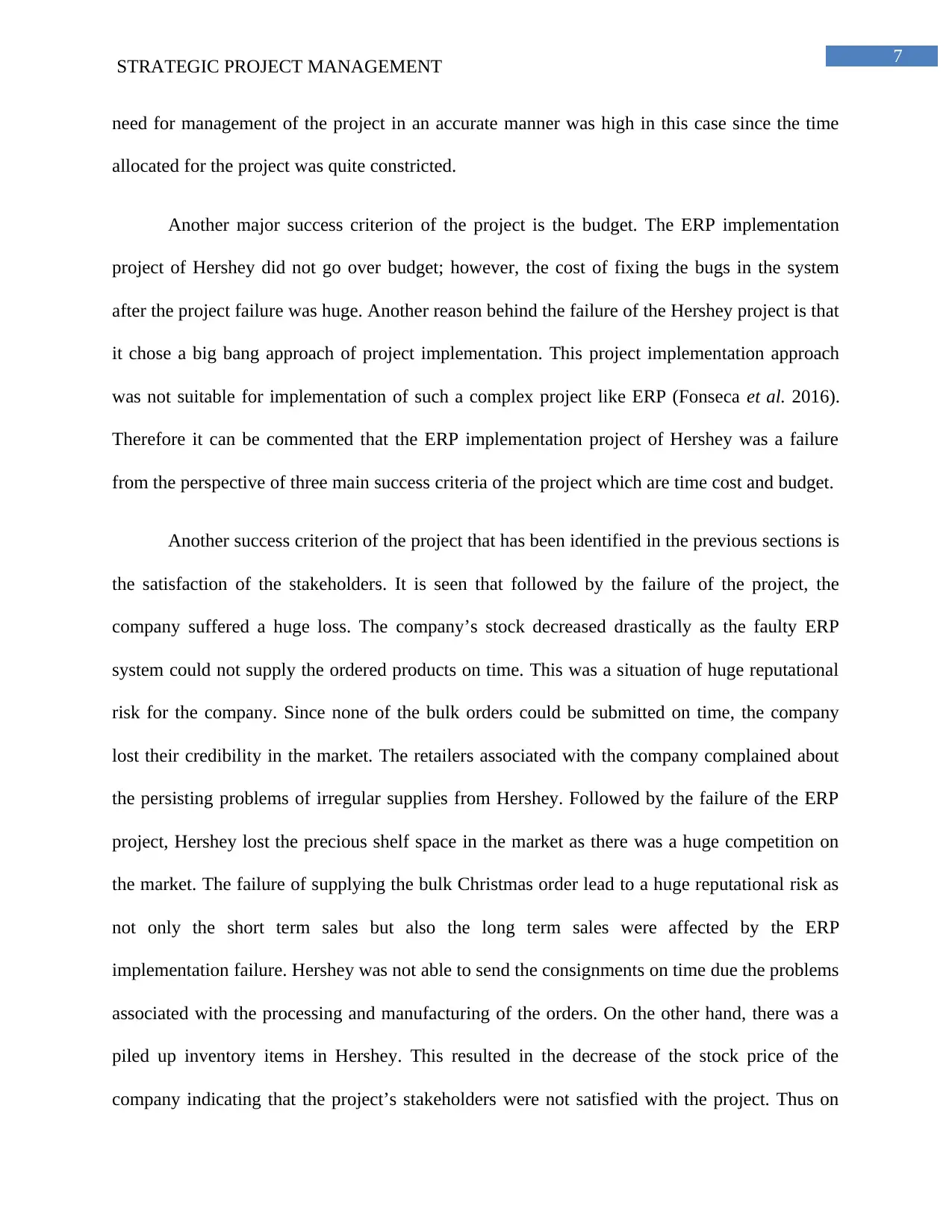
7
STRATEGIC PROJECT MANAGEMENT
need for management of the project in an accurate manner was high in this case since the time
allocated for the project was quite constricted.
Another major success criterion of the project is the budget. The ERP implementation
project of Hershey did not go over budget; however, the cost of fixing the bugs in the system
after the project failure was huge. Another reason behind the failure of the Hershey project is that
it chose a big bang approach of project implementation. This project implementation approach
was not suitable for implementation of such a complex project like ERP (Fonseca et al. 2016).
Therefore it can be commented that the ERP implementation project of Hershey was a failure
from the perspective of three main success criteria of the project which are time cost and budget.
Another success criterion of the project that has been identified in the previous sections is
the satisfaction of the stakeholders. It is seen that followed by the failure of the project, the
company suffered a huge loss. The company’s stock decreased drastically as the faulty ERP
system could not supply the ordered products on time. This was a situation of huge reputational
risk for the company. Since none of the bulk orders could be submitted on time, the company
lost their credibility in the market. The retailers associated with the company complained about
the persisting problems of irregular supplies from Hershey. Followed by the failure of the ERP
project, Hershey lost the precious shelf space in the market as there was a huge competition on
the market. The failure of supplying the bulk Christmas order lead to a huge reputational risk as
not only the short term sales but also the long term sales were affected by the ERP
implementation failure. Hershey was not able to send the consignments on time due the problems
associated with the processing and manufacturing of the orders. On the other hand, there was a
piled up inventory items in Hershey. This resulted in the decrease of the stock price of the
company indicating that the project’s stakeholders were not satisfied with the project. Thus on
STRATEGIC PROJECT MANAGEMENT
need for management of the project in an accurate manner was high in this case since the time
allocated for the project was quite constricted.
Another major success criterion of the project is the budget. The ERP implementation
project of Hershey did not go over budget; however, the cost of fixing the bugs in the system
after the project failure was huge. Another reason behind the failure of the Hershey project is that
it chose a big bang approach of project implementation. This project implementation approach
was not suitable for implementation of such a complex project like ERP (Fonseca et al. 2016).
Therefore it can be commented that the ERP implementation project of Hershey was a failure
from the perspective of three main success criteria of the project which are time cost and budget.
Another success criterion of the project that has been identified in the previous sections is
the satisfaction of the stakeholders. It is seen that followed by the failure of the project, the
company suffered a huge loss. The company’s stock decreased drastically as the faulty ERP
system could not supply the ordered products on time. This was a situation of huge reputational
risk for the company. Since none of the bulk orders could be submitted on time, the company
lost their credibility in the market. The retailers associated with the company complained about
the persisting problems of irregular supplies from Hershey. Followed by the failure of the ERP
project, Hershey lost the precious shelf space in the market as there was a huge competition on
the market. The failure of supplying the bulk Christmas order lead to a huge reputational risk as
not only the short term sales but also the long term sales were affected by the ERP
implementation failure. Hershey was not able to send the consignments on time due the problems
associated with the processing and manufacturing of the orders. On the other hand, there was a
piled up inventory items in Hershey. This resulted in the decrease of the stock price of the
company indicating that the project’s stakeholders were not satisfied with the project. Thus on
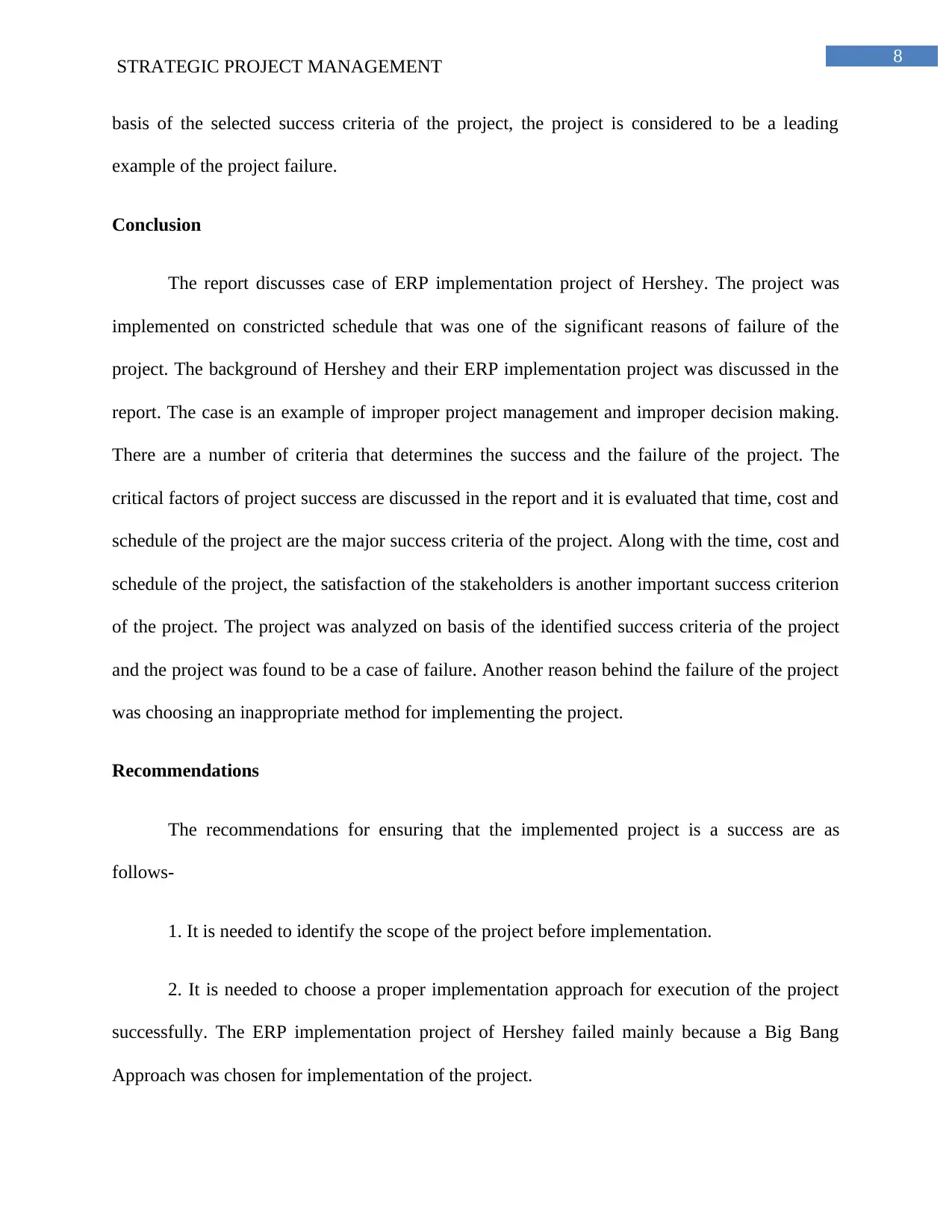
8
STRATEGIC PROJECT MANAGEMENT
basis of the selected success criteria of the project, the project is considered to be a leading
example of the project failure.
Conclusion
The report discusses case of ERP implementation project of Hershey. The project was
implemented on constricted schedule that was one of the significant reasons of failure of the
project. The background of Hershey and their ERP implementation project was discussed in the
report. The case is an example of improper project management and improper decision making.
There are a number of criteria that determines the success and the failure of the project. The
critical factors of project success are discussed in the report and it is evaluated that time, cost and
schedule of the project are the major success criteria of the project. Along with the time, cost and
schedule of the project, the satisfaction of the stakeholders is another important success criterion
of the project. The project was analyzed on basis of the identified success criteria of the project
and the project was found to be a case of failure. Another reason behind the failure of the project
was choosing an inappropriate method for implementing the project.
Recommendations
The recommendations for ensuring that the implemented project is a success are as
follows-
1. It is needed to identify the scope of the project before implementation.
2. It is needed to choose a proper implementation approach for execution of the project
successfully. The ERP implementation project of Hershey failed mainly because a Big Bang
Approach was chosen for implementation of the project.
STRATEGIC PROJECT MANAGEMENT
basis of the selected success criteria of the project, the project is considered to be a leading
example of the project failure.
Conclusion
The report discusses case of ERP implementation project of Hershey. The project was
implemented on constricted schedule that was one of the significant reasons of failure of the
project. The background of Hershey and their ERP implementation project was discussed in the
report. The case is an example of improper project management and improper decision making.
There are a number of criteria that determines the success and the failure of the project. The
critical factors of project success are discussed in the report and it is evaluated that time, cost and
schedule of the project are the major success criteria of the project. Along with the time, cost and
schedule of the project, the satisfaction of the stakeholders is another important success criterion
of the project. The project was analyzed on basis of the identified success criteria of the project
and the project was found to be a case of failure. Another reason behind the failure of the project
was choosing an inappropriate method for implementing the project.
Recommendations
The recommendations for ensuring that the implemented project is a success are as
follows-
1. It is needed to identify the scope of the project before implementation.
2. It is needed to choose a proper implementation approach for execution of the project
successfully. The ERP implementation project of Hershey failed mainly because a Big Bang
Approach was chosen for implementation of the project.
⊘ This is a preview!⊘
Do you want full access?
Subscribe today to unlock all pages.

Trusted by 1+ million students worldwide
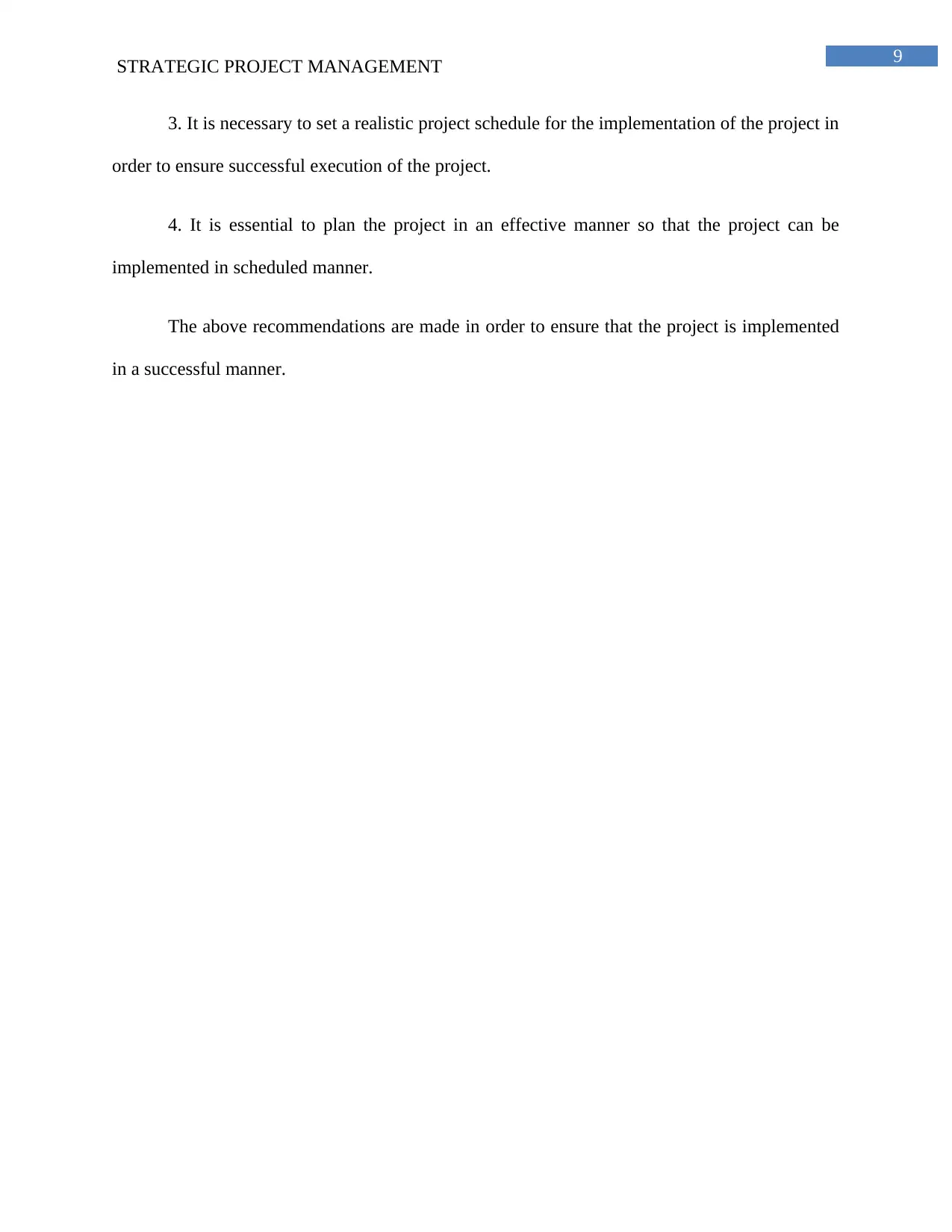
9
STRATEGIC PROJECT MANAGEMENT
3. It is necessary to set a realistic project schedule for the implementation of the project in
order to ensure successful execution of the project.
4. It is essential to plan the project in an effective manner so that the project can be
implemented in scheduled manner.
The above recommendations are made in order to ensure that the project is implemented
in a successful manner.
STRATEGIC PROJECT MANAGEMENT
3. It is necessary to set a realistic project schedule for the implementation of the project in
order to ensure successful execution of the project.
4. It is essential to plan the project in an effective manner so that the project can be
implemented in scheduled manner.
The above recommendations are made in order to ensure that the project is implemented
in a successful manner.
Paraphrase This Document
Need a fresh take? Get an instant paraphrase of this document with our AI Paraphraser
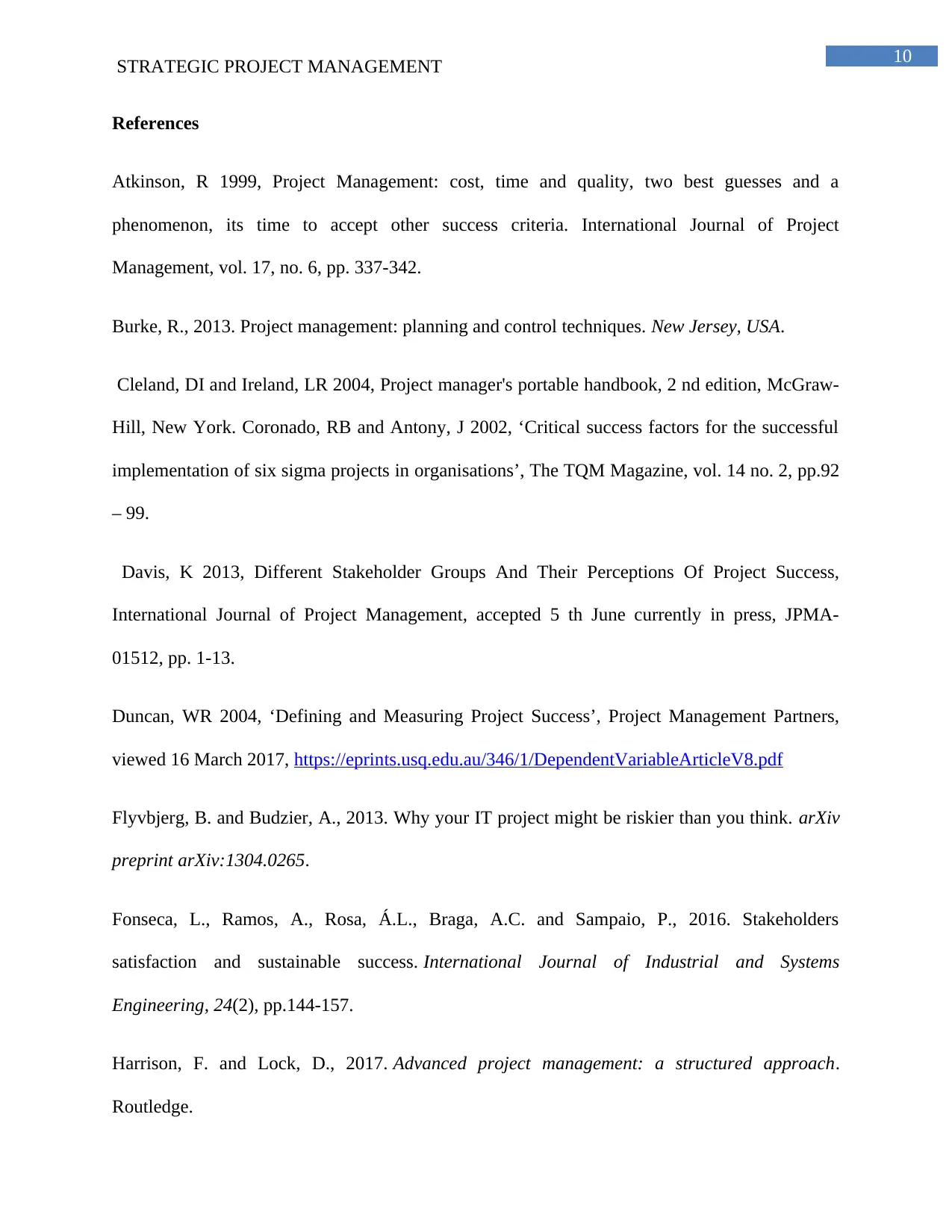
10
STRATEGIC PROJECT MANAGEMENT
References
Atkinson, R 1999, Project Management: cost, time and quality, two best guesses and a
phenomenon, its time to accept other success criteria. International Journal of Project
Management, vol. 17, no. 6, pp. 337-342.
Burke, R., 2013. Project management: planning and control techniques. New Jersey, USA.
Cleland, DI and Ireland, LR 2004, Project manager's portable handbook, 2 nd edition, McGraw-
Hill, New York. Coronado, RB and Antony, J 2002, ‘Critical success factors for the successful
implementation of six sigma projects in organisations’, The TQM Magazine, vol. 14 no. 2, pp.92
– 99.
Davis, K 2013, Different Stakeholder Groups And Their Perceptions Of Project Success,
International Journal of Project Management, accepted 5 th June currently in press, JPMA-
01512, pp. 1-13.
Duncan, WR 2004, ‘Defining and Measuring Project Success’, Project Management Partners,
viewed 16 March 2017, https://eprints.usq.edu.au/346/1/DependentVariableArticleV8.pdf
Flyvbjerg, B. and Budzier, A., 2013. Why your IT project might be riskier than you think. arXiv
preprint arXiv:1304.0265.
Fonseca, L., Ramos, A., Rosa, Á.L., Braga, A.C. and Sampaio, P., 2016. Stakeholders
satisfaction and sustainable success. International Journal of Industrial and Systems
Engineering, 24(2), pp.144-157.
Harrison, F. and Lock, D., 2017. Advanced project management: a structured approach.
Routledge.
STRATEGIC PROJECT MANAGEMENT
References
Atkinson, R 1999, Project Management: cost, time and quality, two best guesses and a
phenomenon, its time to accept other success criteria. International Journal of Project
Management, vol. 17, no. 6, pp. 337-342.
Burke, R., 2013. Project management: planning and control techniques. New Jersey, USA.
Cleland, DI and Ireland, LR 2004, Project manager's portable handbook, 2 nd edition, McGraw-
Hill, New York. Coronado, RB and Antony, J 2002, ‘Critical success factors for the successful
implementation of six sigma projects in organisations’, The TQM Magazine, vol. 14 no. 2, pp.92
– 99.
Davis, K 2013, Different Stakeholder Groups And Their Perceptions Of Project Success,
International Journal of Project Management, accepted 5 th June currently in press, JPMA-
01512, pp. 1-13.
Duncan, WR 2004, ‘Defining and Measuring Project Success’, Project Management Partners,
viewed 16 March 2017, https://eprints.usq.edu.au/346/1/DependentVariableArticleV8.pdf
Flyvbjerg, B. and Budzier, A., 2013. Why your IT project might be riskier than you think. arXiv
preprint arXiv:1304.0265.
Fonseca, L., Ramos, A., Rosa, Á.L., Braga, A.C. and Sampaio, P., 2016. Stakeholders
satisfaction and sustainable success. International Journal of Industrial and Systems
Engineering, 24(2), pp.144-157.
Harrison, F. and Lock, D., 2017. Advanced project management: a structured approach.
Routledge.
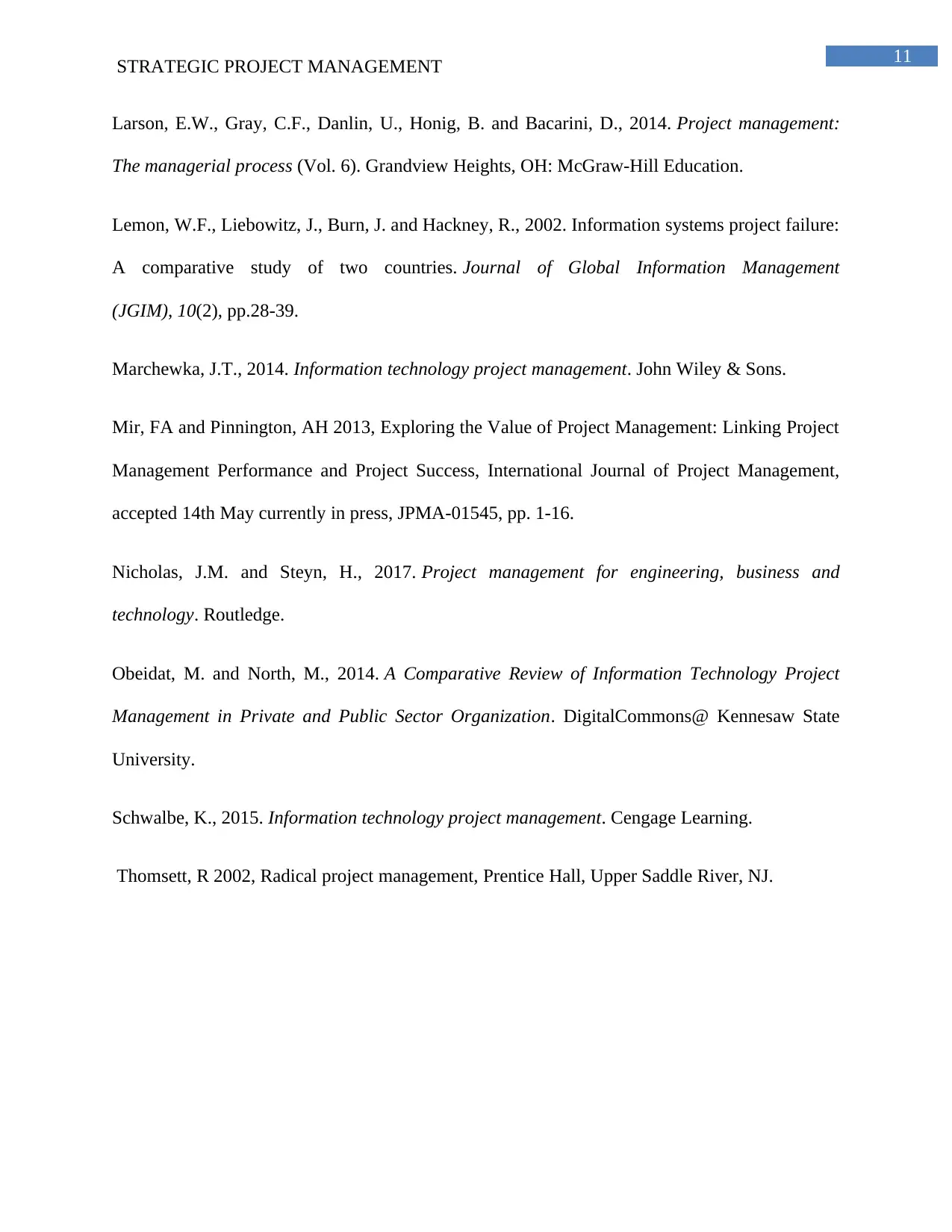
11
STRATEGIC PROJECT MANAGEMENT
Larson, E.W., Gray, C.F., Danlin, U., Honig, B. and Bacarini, D., 2014. Project management:
The managerial process (Vol. 6). Grandview Heights, OH: McGraw-Hill Education.
Lemon, W.F., Liebowitz, J., Burn, J. and Hackney, R., 2002. Information systems project failure:
A comparative study of two countries. Journal of Global Information Management
(JGIM), 10(2), pp.28-39.
Marchewka, J.T., 2014. Information technology project management. John Wiley & Sons.
Mir, FA and Pinnington, AH 2013, Exploring the Value of Project Management: Linking Project
Management Performance and Project Success, International Journal of Project Management,
accepted 14th May currently in press, JPMA-01545, pp. 1-16.
Nicholas, J.M. and Steyn, H., 2017. Project management for engineering, business and
technology. Routledge.
Obeidat, M. and North, M., 2014. A Comparative Review of Information Technology Project
Management in Private and Public Sector Organization. DigitalCommons@ Kennesaw State
University.
Schwalbe, K., 2015. Information technology project management. Cengage Learning.
Thomsett, R 2002, Radical project management, Prentice Hall, Upper Saddle River, NJ.
STRATEGIC PROJECT MANAGEMENT
Larson, E.W., Gray, C.F., Danlin, U., Honig, B. and Bacarini, D., 2014. Project management:
The managerial process (Vol. 6). Grandview Heights, OH: McGraw-Hill Education.
Lemon, W.F., Liebowitz, J., Burn, J. and Hackney, R., 2002. Information systems project failure:
A comparative study of two countries. Journal of Global Information Management
(JGIM), 10(2), pp.28-39.
Marchewka, J.T., 2014. Information technology project management. John Wiley & Sons.
Mir, FA and Pinnington, AH 2013, Exploring the Value of Project Management: Linking Project
Management Performance and Project Success, International Journal of Project Management,
accepted 14th May currently in press, JPMA-01545, pp. 1-16.
Nicholas, J.M. and Steyn, H., 2017. Project management for engineering, business and
technology. Routledge.
Obeidat, M. and North, M., 2014. A Comparative Review of Information Technology Project
Management in Private and Public Sector Organization. DigitalCommons@ Kennesaw State
University.
Schwalbe, K., 2015. Information technology project management. Cengage Learning.
Thomsett, R 2002, Radical project management, Prentice Hall, Upper Saddle River, NJ.
⊘ This is a preview!⊘
Do you want full access?
Subscribe today to unlock all pages.

Trusted by 1+ million students worldwide
1 out of 12
Related Documents
Your All-in-One AI-Powered Toolkit for Academic Success.
+13062052269
info@desklib.com
Available 24*7 on WhatsApp / Email
![[object Object]](/_next/static/media/star-bottom.7253800d.svg)
Unlock your academic potential
Copyright © 2020–2025 A2Z Services. All Rights Reserved. Developed and managed by ZUCOL.





